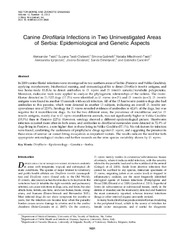Приказ основних података о документу
Canine Dirofilaria Infections in Two Uninvestigated Areas of Serbia: Epidemiological and Genetic Aspects
| dc.creator | Tasić, Aleksandar | |
| dc.creator | Tasic-Otasević, Suzana | |
| dc.creator | Gabrielli, Simona | |
| dc.creator | Miladinovic-Tasić, Nataša | |
| dc.creator | Ignjatović, Aleksandra | |
| dc.creator | Đorđević, Jovana | |
| dc.creator | Dimitrijević, Sanda | |
| dc.creator | Cancrini, Gabriella | |
| dc.date.accessioned | 2020-06-03T13:34:52Z | |
| dc.date.available | 2020-06-03T13:34:52Z | |
| dc.date.issued | 2012 | |
| dc.identifier.issn | 1530-3667 | |
| dc.identifier.uri | https://vet-erinar.vet.bg.ac.rs/handle/123456789/902 | |
| dc.description.abstract | In 2009 canine filarial infections were investigated in two northern areas of Serbia (Pancevo and Veliko Gradiste), applying morphometry, biochemical staining, and immunological kit to detect Dirofilaria immitis antigens, and two home-made ELISAs to detect antibodies to D. repens and D. immitis somatic/metabolic polyproteins. Moreover, molecular tools were applied to analyze the phylogenetic relationships of the isolates. The microfilariae detected in 21/122 dogs (17.2%) were identified as D. repens (n = 21) and D. immitis (n = 2). D. immitis antigens were found in another 13 animals with occult infection. All of the 15 heartworm-positive dogs also had antibodies to this parasite, which were detected in another 13 subjects, indicating an overall D. immitis seroprevalence rate of 22.9%. Serology for D. repens revealed evidence of antibodies in 42.6% of the dogs, but was negative for 4 microfilaremic dogs. As for the two different areas, the prevalence of microfilariae and/or D. immitis antigens, mainly due to D. repens microfilaremic animals, was not significantly higher in Veliko Gradiste (33.3%) than in Pancevo (22%). However, serology showed a different epidemiological picture. Heartworm infection occurred more often in both areas, and antibodies to dirofilarial nematodes were detected in 72.9% of dogs living in Pancevo, a rate higher than in those living in Veliko Gradiste (57.1%). No risk factors for infection were found, confirming the uselessness of prophylactic drugs against D. repens, and suggesting the presence in these areas of sunrise- or sunset-biting mosquitoes as important vectors. The results indicate the need for both appropriate entomological studies and further research on the intra-species variability shown by D. repens. | en |
| dc.publisher | Mary Ann Liebert Inc, New Rochelle | |
| dc.relation | info:eu-repo/grantAgreement/MESTD/Basic Research (BR or ON)/175034/RS// | |
| dc.rights | openAccess | |
| dc.source | Vector-Borne and Zoonotic Diseases | |
| dc.subject | Dirofilaria | en |
| dc.subject | Epidemiology | en |
| dc.subject | Genetics | en |
| dc.subject | Serbia | en |
| dc.title | Canine Dirofilaria Infections in Two Uninvestigated Areas of Serbia: Epidemiological and Genetic Aspects | en |
| dc.type | article | |
| dc.rights.license | ARR | |
| dcterms.abstract | Тасић, Aлександар; Димитријевић, Санда; Ђорђевић, Јована; Габриелли, Симона; Цанцрини, Габриелла; Тасиц-Отасевић, Сузана; Игњатовић, Aлександра; Миладиновиц-Тасић, Наташа; | |
| dc.citation.volume | 12 | |
| dc.citation.issue | 12 | |
| dc.citation.spage | 1031 | |
| dc.citation.epage | 1035 | |
| dc.citation.other | 12(12): 1031-1035 | |
| dc.citation.rank | M21 | |
| dc.identifier.wos | 000312492800004 | |
| dc.identifier.doi | 10.1089/vbz.2011.0949 | |
| dc.identifier.pmid | 23127188 | |
| dc.identifier.scopus | 2-s2.0-84871221060 | |
| dc.identifier.fulltext | https://vet-erinar.vet.bg.ac.rs/bitstream/id/1424/901.pdf | |
| dc.type.version | publishedVersion |

